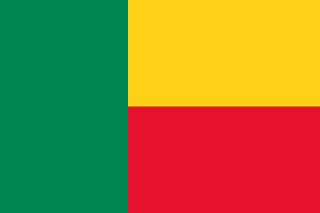These are lists of incumbents, including heads of states or of subnational entities.
The History of Benin since the 16th century, for the geographical area included in 1960 in what was then called the Republic of Dahomey before becoming the People's Republic of Benin.

The Oba of Benin is the traditional ruler and the custodian of the culture of the Edo people and all Edoid people. The then Kingdom of Benin has continued to be mostly populated by the Edo.

Mathieu Kérékou was a Beninese politician who served as president of the People's Republic of Benin from 1972 to 1991 and the Republic of Benin from 1996 to 2006.

The King of Dahomey was the ruler of Dahomey, a West African kingdom in the southern part of present-day Benin, which lasted from 1600 until 1900 when the French Third Republic abolished the political authority of the Kingdom. The rulers served a prominent position in Fon ancestor worship leading the Annual Customs and this important position caused the French to bring back the exiled king of Dahomey for ceremonial purposes in 1910. Since 2000, there have been rival claimants as king and there has so far been no political solution. The Palace and seat of government were in the town of Abomey. Early historiography of the King of Dahomey presented them as absolute rulers who formally owned all property and people of the kingdom. However, recent histories have emphasized that there was significant political contestation limiting the power of the king and that there was a female ruler of Dahomey, Hangbe, who was largely written out of early histories.
Ketu is the name of a Yoruba subgroup, historical kingdom and region straddling parts of what is now southeastern Republic of Benin and parts of southwest Nigeria. The chief town and traditional capital of the area was the town of Kétou (Kétu), which is considered to be one of the oldest capitals of the Yoruba-speaking people, tracing its establishment to a settlement founded by a descendant of Oduduwa called Sopasan or Soipasan. The Oba of the town were traditionally styled "Alákétu", and are related directly to Ile-Ife in present-day Nigeria. Other towns that were historically part of the Kétu Kingdom are;

The Oba of Lagos, also known as the Eleko of Eko, is the traditional ruler (Oba) of Lagos.
Oba means "ruler" in the Yoruba language. Kings in Yorubaland, a region which is in the modern republics of Benin, Nigeria and Togo, make use of it as a pre-nominal honorific. Examples of Yoruba bearers include Oba Ogunwusi of Ile-Ife, Oba Aladelusi of Akure, and Oba Akiolu of Lagos. An example of a Bini bearer is Oba Ewuare II of Benin.

Benin art is the art from the Kingdom of Benin or Edo Empire (1440–1897), a pre-colonial African state located in what is now known as the Southern region of Nigeria. Primarily made of cast bronze and carved ivory, Benin art was produced mainly for the court of the Oba of Benin – a divine ruler for whom the craftsmen produced a range of ceremonially significant objects. The full complexity of these works can be appreciated through the awareness and consideration of two complementary cultural perceptions of the art of Benin: the Western appreciation of them primarily as works of art, and their understanding in Benin as historical documents and as mnemonic devices to reconstruct history, or as ritual objects. This original significance is of great importance in Benin.

The Kingdom of Nri was a medieval polity located in what is now Nigeria. The kingdom existed as a sphere of religious and political influence over a significant part of what is known today as Igboland prior to expansion, and was administered by a priest-king called an Eze Nri. The Eze Nri managed trade and diplomacy on behalf of the Nri people, a subgroup of the Igbo-speaking people, and possessed divine authority in religious matters.

The Yoruba of West Africa are responsible for a distinct artistic tradition in Africa, a tradition that remains vital and influential today.

The following outline is provided as an overview of and topical guide to Benin:
Benin, officially the Republic of Benin, is a country in Western Africa. It borders Togo to the west, Nigeria to the east and Burkina Faso and Niger to the north; its short coastline to the south leads to the Bight of Benin. Its size is just over 110000 km2 with a population of almost 8500000. Its capital is the Yoruba founded city of Porto Novo, but the seat of government is the Fon city of Cotonou. About half the population live below the international poverty line of US$1.25 per day.

The Kingdom of Benin, also known as Great Benin or Benin Kingdom is a kingdom within what is now southern Nigeria. It has no historical relation to the modern republic of Benin, which was known as Dahomey from the 17th century until 1975. The Kingdom of Benin's capital was Edo, now known as Benin City in Edo State, Nigeria. The Benin Kingdom was "one of the oldest and most developed states in the coastal hinterland of West Africa". It grew out of the previous Edo Kingdom of Igodomigodo around the 11th century AD, and lasted until it was annexed by the British Empire in 1897.

The Bronze Head from Ife, or Ife Head, is one of eighteen copper alloy sculptures that were unearthed in 1938 at Ife in Nigeria, the religious and royal centre of the Yoruba people. It is believed to represent a king. It was probably made in the 12th-13th century CE. The realism and sophisticated craftsmanship of the objects challenged the dismissive and patronising Western conceptions of African art. The naturalistic features of the Ife heads are unique and the stylistic similarities of these works "suggest that they were made by an individual artist or in a single workshop."